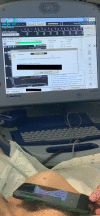Magnetic Interference on Cardiac Implantable Electronic Devices From Apple iPhone MagSafe Technology
- PMID: 34074132
- PMCID: PMC8477860
- DOI: 10.1161/JAHA.121.020818
Magnetic Interference on Cardiac Implantable Electronic Devices From Apple iPhone MagSafe Technology
Abstract
Background Magnet wireless charging is being utilized increasingly in current generation smartphones. Apple's MagSafe is a proprietary wireless charging technology with an array of magnets that has the capacity to generate magnet fieldstrength >50 gauss (G). We hypothesize that there is clinically significant magnet interference caused by Apple's MagSafe technology on cardiac implantable electronic devices (CIED). Methods and Results This study has an in vivo and an ex vivo component. The in vivo component consists of consecutive patients who presented to the electrophysiology laboratory with previously implanted CIEDs. The iPhone 12 Pro Max was directly placed on the skin over the pocket of these patients and the effect was studied by device interrogation. For the ex vivo component of the study, CIEDs from major device companies were tested for magnetic interference caused by iPhone 12 Pro Max through unopened packages. We found that iPhone 12 Pro Max resulted in clinically identifiable magnet interference in 3/3 (100%) participants in vivo and in 8/11 (72.7%) devices ex vivo. Conclusions Apple's iPhone 12 Pro Max MagSafe technology can cause magnet interference on CIEDs and has the potential to inhibit lifesaving therapy.
Keywords: hall‐effect sensor; implantable cardioverter/defibrillator; magnet; pacemaker; reed switch; smartphone.
Conflict of interest statement
None.
Figures


References
-
- Health C for D and R . Potential cell phone interference with pacemakers and other medical devices. FDA . Published online October 2, 2020.
-
- Accessory design guidelines for Apple devices. Apple Inc website. Updated October 16, 2021. Available at: https://developer.apple.com/accessories/Accessory‐Design‐Guidelines.pdf. Accessed December 10, 2020.
MeSH terms
LinkOut - more resources
Full Text Sources
Medical

